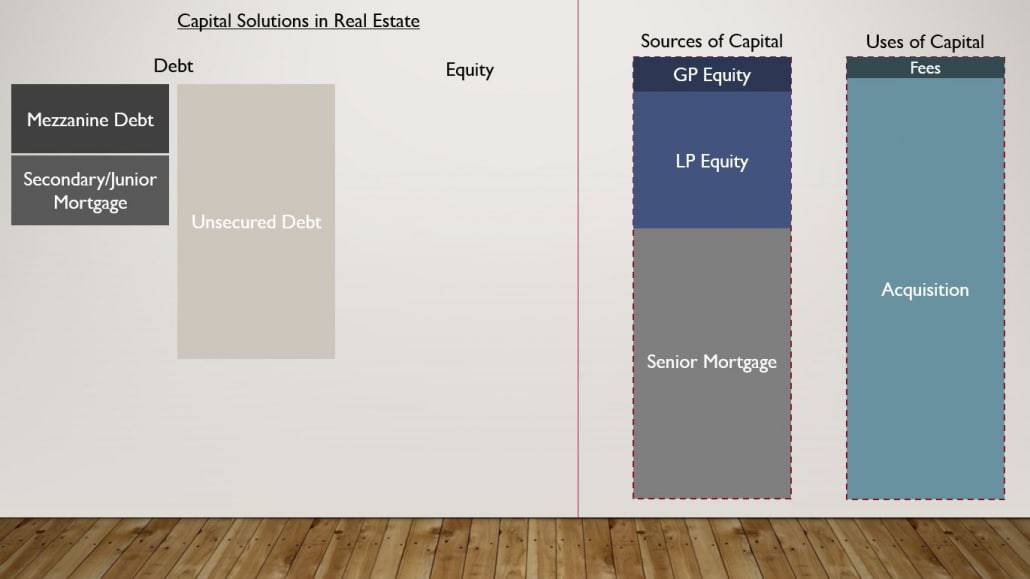Analyzing a Real Estate Investment from the Perspective of an LP
We received a question from an A.CRE reader this week that I thought warranted a thorough response. The question was, and I paraphrase, “I am an LP looking for models to help vet syndication deals. Do you have any models that can be used to evaluate a deal from the perspective of an LP, as well as gauge the impact of GP fees on LP and GP returns?”
The answer is yes. In fact, virtually every model in our Library of Real Estate Excel models can be used by LP’s as well as GP’s.
So in this post, I’ll walk through how a limited partner might go about analyzing an investment brought by a general partner, and then share a few of our models that are best suited for analysis by LPs.
Note: Throughout this post, I use the terms GP and Sponsor interchangeable.

A slide used in our real estate financial modeling Accelerator training program – Sources and Uses of Capital
Analyzing a Real Estate Investment – LP’s Process
So let’s imagine you’re a high net worth individual interested in allocating a portion of your investment capital to real estate. You want to make direct investments in real estate, rather than purchase REIT stock, but you don’t want to manage the real estate. So you turn to a real estate sponsor (i.e. GP or general partner) to help make this happen.
That sponsor begins to send you opportunities, but how should you go about analyzing those investments? Here’s the process I’d recommend following:
1. Review the Offering Materials
The sponsor should send you, at minimum, an overview of the property, the market, financial projections, and a biography of them and their management team. Ideally, the sponsor will also send you support for their assumptions and conclusions. This might include data on market vacancy, rent growth, and supply. It might also include rent, sale, and expense comps.
Additionally, at some point all other supplementary information necessary to do you due diligence will need to be provided. This includes things such as property condition reports, environmental assessments, site plans, surveys, etc.
2. Model the GP’s Base Case
Next, you’ll need to model a base case using the GP’s assumptions. This can be done using your own model (i.e. Excel spreadsheet or non-Excel alternative) or the model provided by the GP. This analysis should include property-level cash flows and returns, both unlevered and levered. It should also include partnership-level cash flows and returns for both the GP and LP.
The result of this first step of your analysis should match the result of the GP’s analysis. This is important so you can understand the assumptions the GP is using to arrive at its conclusion.
3. Adjust the GP’s Assumptions to Arrive at your Own Conclusions
Once you have a base case using the GP’s assumptions, duplicate that model and begin to make adjustments to the GP’s assumptions in the duplicated version. Go through every assumption made by the GP (e.g. rent, concessions, other income, vacancy, operating expenses, capital expenditures, debt, timing, partnership structure, etc.) and make adjustments based on your own knowledge of the market and consistent with how you’ve underwritten similar deals in the past.
Remember that the GP earns fees, and thus is incentivized to transact. That and the general optimistic nature of sponsors means you must bring a skeptical eye to the process. This isn’t necessarily a bad thing, but it likely means that your more skeptical view will result in conclusions that will be less aggressive than those of the sponsor.
4. Stress Test the Property-Level Assumptions
With the GP base case and your adjusted analysis complete, it’s good practice to then stress the deal. Duplicate your version of the analysis, and run a third (and possibly) fourth iteration of the analysis using assumptions that test possible downside scenarios. Also referred to as sensitivity analysis or scenario analysis, this process can also be done using data tables.
More sophisticated LPs may also employ probabilistic analysis at this stage. While atypical for the industry, it’s another method for assessing the upside and downside potential of an investment.
5. Assess the Impact of GP Fees and Promotes
The GP sponsors real estate investments in exchange for asset management, property management, development, acquisition, disposition and other sponsor fees. It also generally expects to earn a promoted interest for exceeding certain return thresholds.
While this is typical for the industry, some GPs charge more than others. This next step is important to understand whether the GP’s fees and structure are expensive or not.
With the investment analysis done, it’s important to dig into how much hard cash the GP will have into the deal and how much the GP will earn from the investment.
Now this might seem obvious. A 3% asset management fee is more expensive than a 1% asset management fee, wheras a 1% acquisition fee is better than a 2% acquisition fee. But it’s not always so obvious.
For instance, imagine a sponsor brings a development opportunity with a 2.5% development fee when you typically expect to pay 3% – 4%. You might immediately assume that the fee is cheap. But as you dig into the deal further, you discover that the sponsor purchased the land 24 months ago and intends to contribute the land to the venture at “market value”. The sponsor’s market value for the land is dubious, and substantially high than what the sponsor paid for the land just two years ago.
So while the development fee may be below market, the elevated land cost means the sponsor is essentially earning a big fee upfront. Assessing the impact of GP compensation will help you determine whether you’re overpaying, in terms of fees and promote, relative to other opportunities.
Analyzing Real Estate from the LP’s Perspective – A Video Discussion
To supplement this post, I created a quick video where I talk through analyzing a real estate investment from the LP’s perspective. In this video, I give an overview of where the LP fits into the real estate capital stack and then show you two models that might be used to compare LP and GP returns.
Real Estate Financial Models to Analyze from the LP’s Perspective
As I said at the top, virtually every model and module within our library can be used to help LPs analyze potential opportunities. Nevertheless, I’ve listed below a few of the more advanced models we’ve shared over the years and which property types they’re best suited for.
1. The All-in-One Model for Acquisition and Development
The All-in-One model is intended to handle most acquisition and development scenarios for all property types except for hotel, although back-of-the-envelope hotel analysis is also possible. It is the most downloaded and tested model on our site, having been downloaded nearly 50,000 times and updated over 40 times since its release in 2017.
The downside to this model is that because it can handle so many scenarios, it is complicated and bulky. Thus, we’ve also created specialty models that provide more refined analysis for specific property types and/or scenarios.
2. Hotel Acquisition and Hotel Development Models
In 2019, Michael shared three hotel models: an Advanced Hotel Acquisition and Valuation Model, a Basic Hotel Acquisition Model, and a Hotel Development Model.
The advanced hotel acquisition model was our first hotel model on the site, and it’s a beast! It really is capable of handling every hotel acquisition scenario imaginable and allow the user to get into the underwriting weeds, so to speak. But it’s also incredibly complicated to use. As a result, he followed that model up with a basic hotel acquisition model. The basic model can handle most situations, while being easier and faster to use.
His hotel development model is a more recent release, and is a hybrid of his Basic Hotel Acquisition Model and his Condominium Development Model with a lot of customization work added.
3. Value-Add Apartment Acquisition and Apartment Development Models
My favorite models on the site, our Value-Add Apartment Acquisition model and Apartment Development Model, use a unique design where virtually all inputs are on one tab. While being incredibly simple to use, the models are still as robust as any apartment model you’ll find out there, including those at top real estate institutions.
In the coming years, I plan to release models using this design for each of the main property types.
4. Simple Acquisition Model for Office, Retail, and Industrial
Our Simple Acquisition Model for Office, Retail, and Industrial model is one of the older models on our site, which means it’s gone through quite a few iterations. As with all of the previously mentioned models, it includes modules for modeling both property-level and partnership-level cash flow and returns.
5. Various Equity Waterfall Models
If you prefer to use the sponsor’s property-level cash flows and just assess the partnership-level returns on your own, you can use one of our equity waterfall models. These models are not standalone, but rather must be integrated with a property-level model. But they allow you to test various partnership structures quickly and accurately. Here are a few of the waterfall models we’ve shared over the years:
- Real Estate Equity Waterfall Model – Annual with IRR and EMx Hurdles. The model assumes the GP does not earn a promoted interest until the LP has received a full return of capital plus hit its preferred return hurdle. This structure is sometimes referred to as a European Waterfall.
- Real Estate Equity Waterfall Model – Monthly with IRR Hurdles. The model assumes the GP does not earn a promoted interest until the LP has received a full return of capital plus hit its preferred return hurdle. This model also includes a GP IRR Catch Up feature as well as the option to calculate IRR using monthly or annual compounding.
- Real Estate Equity Waterfall Model – Non-Compounding Hurdle. Also referred to as the Equity Waterfall Model with Cash-on-Cash hurdles, this model uses a common (but basic) structure whereby preferred return is non-compounding. It also assumes that the sponsor is paid a promoted interest during operation before the LP has received a full return of capital. The scenario where the GP earns a fee before LP’s capital is returned is sometimes called an American Waterfall.
Conclusion
In conclusion, analyzing real estate investments from the perspective of a limited partner (LP) involves a detailed and methodical approach. By reviewing the sponsor’s offering materials, modeling the GP’s base case, adjusting assumptions, stress testing property-level assumptions, and assessing the impact of GP fees, LPs can make informed decisions.
For those looking to deepen their understanding and enhance their analytical skills, consider exploring our new Data Analysis GPT for Commercial Real Estate. This tool uses AI technology to help streamline your complex data analysis tasks. Whether it’s enhancing your hold-sell analyses like we discussed in this article or tackling other data-intensive tasks in CRE, the Data Analysis GPT can provide powerful support.
Frequently Asked Questions about Analyzing a Real Estate Investment from the Perspective of an LP
What is the first step an LP should take when analyzing a potential real estate investment?
The first step is to review the offering materials provided by the GP, which should include an overview of the property, market analysis, financial projections, sponsor bios, and supporting data such as comps and third-party reports.
How should an LP model the GP’s base case?
An LP should replicate the GP’s assumptions in a financial model (either their own or the GP’s) to verify the sponsor’s conclusions. This step helps the LP understand the underlying assumptions and confirm that outputs align with the GP’s projections.
Why is it important for LPs to adjust the GP’s assumptions?
GPs are often optimistic and incentivized to transact. LPs should adjust assumptions based on their own experience and market knowledge to develop a more conservative and realistic assessment of the deal’s potential.
What is the purpose of stress testing a real estate investment model?
Stress testing helps evaluate the deal’s performance under downside scenarios. This process—also known as sensitivity or scenario analysis—prepares LPs for potential risks and determines the investment’s resilience to changes in key variables.
How can LPs assess the impact of GP fees and promotes?
LPs should analyze how much the GP earns through fees (e.g., acquisition, asset management) and promoted interest. It’s essential to determine whether GP compensation is in line with market norms or if excessive value is being extracted upfront.
What Excel models are recommended for LPs analyzing potential deals?
Models recommended for LPs include:
All-in-One Model for various property types
Hotel Acquisition/Development Models
Value-Add Apartment Models
Simple Acquisition Model for Office, Retail, Industrial
Equity Waterfall Models for partnership-level analysis
Can LPs use equity waterfall models independently of property-level models?
No. The equity waterfall models shared are not standalone tools. They must be integrated with a property-level model to evaluate how returns are distributed between GP and LP based on cash flows and the structure of the deal.
What role does skepticism play in LP investment analysis?
Skepticism helps LPs avoid over-reliance on GP assumptions. By independently validating numbers and questioning optimistic projections, LPs protect themselves from overpaying or underestimating risk in a deal.
Where can LPs learn more or get help with modeling?
LPs can access support via the A.CRE Accelerator Program, use A.CRE Consulting for custom projects, or explore tools like the Data Analysis GPT for Commercial Real Estate to deepen modeling and analytical skills.









